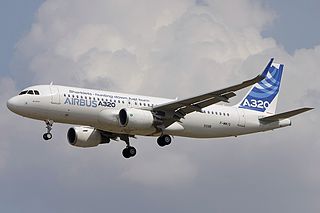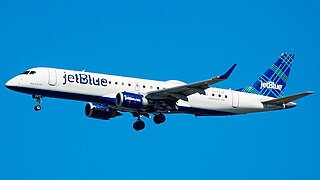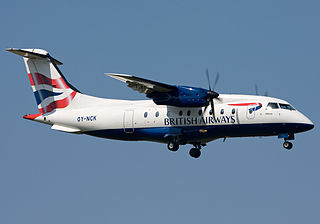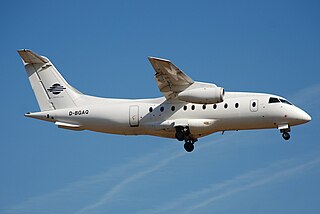
Dornier Flugzeugwerke was a German aircraft manufacturer founded in Friedrichshafen in 1914 by Claude Dornier. Over the course of its long lifespan, the company produced many designs for both the civil and military markets.

DASA was a German aerospace manufacturer.

The Boeing 737 is a narrow-body aircraft produced by Boeing at its Renton factory in Washington. Developed to supplement the Boeing 727 on short and thin routes, the twinjet retained the 707 fuselage width and six abreast seating but with two underwing turbofans instead of four. Envisioned in 1964, the initial 737-100 made its first flight in April 1967 and entered service in February 1968 with Lufthansa. The lengthened 737-200 entered service in April 1968, and evolved through four generations, offering several variants for 85 to 215 passengers.

The Airbus A320 family is a series of narrow-body airliners developed and produced by Airbus. The A320 was launched in March 1984, first flew on 22 February 1987, and was introduced in April 1988 by Air France. The first member of the family was followed by the longer A321, the shorter A319, and the even shorter A318 . Final assembly takes place in Toulouse in France; Hamburg in Germany; Tianjin in China since 2009; and Mobile, Alabama in the United States since April 2016.

The Airbus A321 is a member of the Airbus A320 family of short to medium range, narrow-body, commercial passenger twin engine jet airliners; it carries 185 to 236 passengers. It has a stretched fuselage which was the first derivative of the baseline A320 and entered service in 1994, about six years after the original A320. The aircraft shares a common type rating with all other Airbus A320-family variants, allowing A320-family pilots to fly the aircraft without the need for further training.

The Fokker F28 Fellowship is a twin-engined, short-range jet airliner designed and built by Dutch aircraft manufacturer Fokker.

The Fokker 100 is a regional jet that was produced by Fokker in the Netherlands. The Fokker 100 was based on the Fokker F28 with a fuselage stretched by 18.8 ft (5.7 m) to seat up to 109 passengers, up from 85. It is powered by two newer Rolls-Royce Tay turbofans, and it has an updated glass cockpit and a wider wing and tail for increased maximum weights.

The Embraer E-Jet family is a series of four-abreast, narrow-body, short- to medium-range, twin-engined jet airliners designed and produced by Brazilian aerospace manufacturer Embraer.

The Bombardier Challenger 600 series is a family of business jets developed by Canadair after a Bill Lear concept, and then produced from 1986 by its new owner, Bombardier Aerospace. At the end of 1975, Canadair began funding the development of LearStar 600, and then bought the design for a wide-cabin business jet in April 1976. On 29 October, the programme was launched, backed by the Canadian federal government, and designed to comply with new FAR part 25 standards.
Skyway Airlines was an American ramp and aircraft ground handling services and catering company based in Oak Creek, Wisconsin. Until April 5, 2008, it operated as a regional airline and banner carrier exclusively for Midwest Express Airlines under the business name Midwest Connect, feeding Midwest's hub at General Mitchell International Airport with twelve 32-seat Fairchild-Dornier 328JET regional jet aircraft, and four 19-seat Beechcraft 1900 commuter turboprops. Skyway Airlines, along with its parent corporation, Midwest Air Group, has since ceased operations.

The Dornier 328 is a turboprop-powered commuter airliner. Initially produced by Dornier Luftfahrt GmbH, the firm was acquired in 1996 by Fairchild Aircraft. The resulting firm, named Fairchild-Dornier, manufactured the 328 family in Oberpfaffenhofen, Germany, conducted sales from San Antonio, Texas, United States, and supported the product line from both locations. A jet-powered version of the aircraft, the Fairchild Dornier 328JET, was also produced.

The Baade 152 also known as Dresden 152, VL-DDR 152 or simply 152, was a post-war airliner designed and manufactured by East German aircraft company VEB Flugzeugwerke Dresden. The aircraft was named after German aeronautical engineer Brunolf Baade, the principal designer involved in the programme. It had the distinction of being the first jet airliner to be developed in Germany.

The Fairchild-Dornier 328JET is a commuter airliner, based upon the turboprop-powered Dornier 328, developed by the German aircraft manufacturer Dornier Luftfahrt GmbH. It would be the last Dornier-designed aircraft to reach production before the company's collapse during the early 2000s.

A regional jet (RJ) is a jet-powered regional airliner with fewer than 100 seats. The first one was the Sud-Aviation Caravelle in 1959, followed by the widespread Yakovlev Yak-40, Fokker F-28, and BAe 146. The 1990s saw the emergence of the most widespread Canadair Regional Jet and its Embraer Regional Jet counterpart, then the larger Embraer E-Jet and multiple competing projects. In the US, they are limited in size by scope clauses.

A hydrogen-powered aircraft is an aeroplane that uses hydrogen fuel as a power source. Hydrogen can either be burned in a jet engine or another kind of internal combustion engine, or can be used to power a fuel cell to generate electricity to power an electric propulsor. It cannot be stored in a traditional wet wing, and hydrogen tanks have to be housed in the fuselage or be supported by the wing.

The Fairchild Dornier 428JET was a program undertaken by American company Fairchild Dornier to develop a 44-seat regional jet aircraft. The program was part of a broader attempt by the company to develop a family of regional jets, comprising the 328JET, 428JET, and the 728 series. This family of aircraft was designed to compete with the Bombardier CRJ and Embraer ERJ/Embraer E-Jets families. The aircraft was announced on May 19, 1998. It was cancelled in August 2000.

The Bombardier CRJ100 and CRJ200 is a regional jet designed and manufactured by Bombardier Aerospace between 1991 and 2006, the first of the Bombardier CRJ family.

The Bombardier CRJ550, CRJ700, CRJ705, CRJ900, and CRJ1000 are a family of regional jet airliners that were designed and manufactured by Canadian transportation conglomerate Bombardier between 1999 and 2020. Their design was derived from the smaller CRJ100 and 200 airliners, the other members of the Bombardier CRJ aircraft family. The CRJ program was acquired by the Japanese corporation Mitsubishi Heavy Industries in 2020, which ended production of the aircraft.

The Lockheed Martin X-55 Advanced Composite Cargo Aircraft (ACCA) is an experimental twinjet transport aircraft. It is intended to demonstrate new air cargo-carrier capabilities using advanced composite materials. A project of the United States Air Force's Air Force Research Laboratory, it was built by the international aerospace company Lockheed Martin, at its Advanced Development Programs facility in Palmdale, California.
A hybrid electric aircraft is an aircraft with a hybrid electric powertrain. As the energy density of lithium-ion batteries is much lower than aviation fuel, a hybrid electric powertrain may effectively increase flight range compared to pure electric aircraft. By May 2018, there were over 30 hybrid electric aircraft projects, and short-haul hybrid-electric airliners were envisioned from 2032.




















